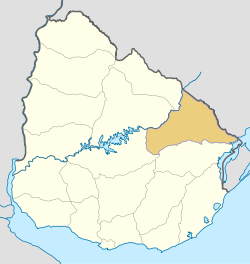Cerro Largo Department
| Cerro Largo Department | |||
|---|---|---|---|
|
|||
| Location of Cerro Largo Department & its capital | |||
| Coordinates (Melo): 32°22′S 54°11′W / 32.367°S 54.183°W | |||
| Country |
|
||
| Capital of Department | Melo | ||
| Government | |||
| • Intendant | Sergio Botana | ||
| • Ruling party | Partido Nacional | ||
| Area | |||
| • Total | 13,648 km2 (5,270 sq mi) | ||
| Population (2011 census) | |||
| • Total | 84,698 | ||
| • Density | 6.2/km2 (16/sq mi) | ||
| Demonym(s) | arachán, cerrolarguense | ||
| Time zone | UYT (UTC-3) | ||
| ISO 3166 code | UY-CL | ||
| Website | Official site | ||
Cerro Largo Department (Spanish pronunciation: [ˈsero ˈlarɣo]) is a department of Uruguay. Its capital is Melo. It is located in the east of the country, bordering Brazil to its northeast with Yaguaron River as the natural border, Treinta y Tres Department to its south, Durazno Department to its west and the departments of Tacuarembó and Rivera to its northwest with Negro River as its natural border with them.
At the end of the 18th century, apart from the indigenous people, the area was populated by the Spanish and the Portuguese alike. In 1795, the Captain of the Spanish Infantry Agustín de la Rosa founded the town of Melo, a fortress to repel attacks of the Portuguese and the Indios. The territory was invaded by the Portuguese in 1801, 1811, and 1816. The history of this place is marked by battles before, during and after the Independence of the Republic.
The old Posta del Chuy, 15 kilometres (9.3 mi) from the town, was the historic Inn where travellers from Melo to Villa Artigas (the actual Río Branco) could rest and pay the fares for using the first public work of the Republic, the stone bridge over the stream Chuy del Tacuarí, today a Heritage Monument, built in 1855 by the French Basque brothers Etcheverry.
In 1830, when Uruguay was divided in nine departments, Cerro Largo was one of them, including the biggest part of what was later separated as the Treinta y Tres Department.
During the 19th and early 20th centuries, when intermittent periods of civil war occurred in Uruguay, the department was a stronghold of the Blanco party. This was the precursor of the Partido Nacional.
Local people are usually known as "arachanes", in memory of an extinct local ethnicity, the Arachán people.
...
Wikipedia



